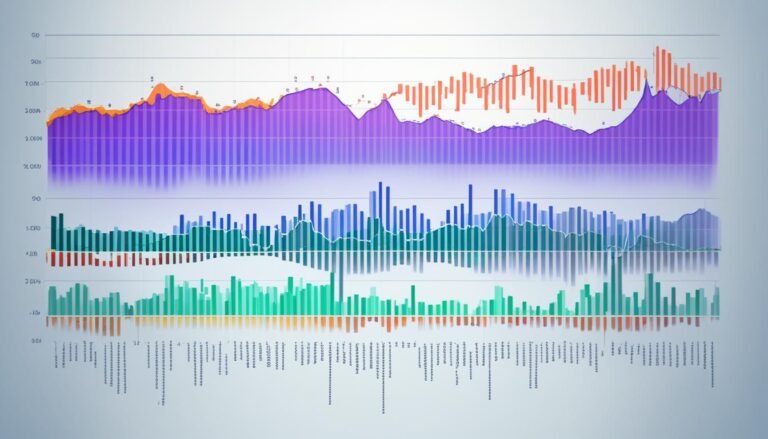Cryptocurrency Derivatives: Understanding Futures, Options, and Swaps
The global $3 trillion cryptocurrency derivatives market is huge. It shows the world’s growing interest in these financial products. Both new and experienced traders need to understand futures, options, and swaps. These tools help manage risks and maximize profits in digital asset trading.
Crypto futures allow traders to safeguard against market changes. Options trading offers advanced strategies for those who wish to delve deeper. Let’s look closer at how these tools operate, their benefits, and potential drawbacks.
Key Takeaways
- The cryptocurrency derivatives market’s value exceeds $3 trillion, underlining its importance.
- Knowledge of futures, options, and swaps is vital for managing risks and increasing profits when trading cryptocurrencies.
- Futures contracts allow traders to protect against market shifts, increasing stability in volatile markets.
- Options provide sophisticated trading approaches and more flexibility than direct investing.
- It’s crucial to balance the advantages and risks of cryptocurrency derivatives for informed decision-making.
- Understanding these tools is key to earning substantial profits and securing a strong market position.
Introduction to Cryptocurrency Derivatives
Cryptocurrency derivatives have changed how we engage with digital assets. This introduction to derivatives in crypto markets shows the important flexibility and leverage they bring to traders. Such financial tools, common in stocks, have moved into crypto, opening up new derivative trading chances.
Derivatives in crypto are like those in traditional finance. They are contracts tied to the value of digital currencies. You’ll find futures, options, and swaps, offering various ways to trade and manage risks. As crypto markets grow, more people and big investors are getting into derivative trading.
“Incorporating derivatives into crypto trading allows for sophisticated risk management and exposure techniques, thus attracting a wider segment of the investment community,” said Binance, a leading cryptocurrency exchange.
This shift is boosting market liquidity and improving how prices are set. With more traders using derivatives, the market is becoming more stable and efficient. The World Economic Forum believes that adding derivatives to crypto can lead to new, innovative investment approaches.
| Type of Derivative | Primary Function | Key Players |
|---|---|---|
| Futures | Allows trading on the direction of the market | Binance, CME Group |
| Options | Provides right, but not obligation, to trade | Deribit, LedgerX |
| Swaps | Exchange of cash flows or other financial instruments | BitMex, OKEx |
To wrap it up, crypto markets are changing with the introduction of derivative trading. This brief introduction to derivatives lays the groundwork for exploring more on crypto derivatives.
Crypto Futures Contracts: An Overview
Crypto futures contracts are agreements for buying or selling a cryptocurrency in the future. This happens at a set price and time. They let traders guess the future prices of cryptocurrencies. People also use them to lower risks and protect their investments.
Definition and Types of Futures Contracts
Knowing about types of futures contracts is key for those wanting to trade. The main types of futures are:
- Standard Futures Contracts: These have fixed terms for the asset amount, when it settles, and how.
- Perpetual Futures Contracts: They don’t end by a certain date and can be extended as needed.
How Crypto Futures Contracts Work
To understand how futures work, let’s look at the basics. Traders agree to swap the cryptocurrency they hold at a future date. They do this for an agreed price today. This method lets them gain or lose money from price changes without owning the asset yet. Crypto exchanges with futures trading typically handle this.
Advantages and Risks of Trading Crypto Futures
Trading crypto futures has its perks but also comes with big risks. The good parts include:
- It lets traders control a big share of the market with a small upfront cost.
- They can bet on prices going up or down.
- It’s a way to protect against market swings, known as hedging.
Yet, the risks shouldn’t be overlooked, like:
- Market Volatility: Fast and big changes in prices can cause major losses without a good plan.
- Leverage Risks: While it can increase wins, it can also make losses bigger.
Understanding and managing both advantages and risks is crucial for using crypto futures well. This means careful strategy and risk handling at all times.
Exploring Crypto Options Strategies
Starting with crypto options might feel overwhelming, but it’s not that hard if you take it step by step. Knowing the various types of crypto options and using efficient trading strategies can help you make smart moves. This will lead to making money while keeping risks low in the ever-changing market.
Types of Crypto Options
In the crypto world, options mostly fall into two groups: call options and put options. Calls give you the right to buy a crypto at a set price. Puts let you sell at that price. With these basics, you can start building your crypto options strategies.
Popular Crypto Options Trading Strategies
There are several trading strategies depending on what the market looks like and how much risk you can handle. Here are some common approaches:
- Long Call: With this, you buy call options hoping the crypto’s value goes up.
- Long Put: In contrast, traders buy put options assuming the crypto’s value will drop.
- Covered Call: It’s a safer tactic. You own the asset and sell call options on it.
- Protective Put: Buying a put option to shield your investment from dropping too much, a key part of risk management.
Understanding the Risks Involved
Trading crypto options is risky business. That’s why good risk management is vital to tackle market ups and downs. Be ready for possible losses when options expire without value. Staying informed by reading market updates and analyses can help you make wise choices and lower your risks.
Cryptocurrency Swaps Agreements
Cryptocurrency swaps are key in the digital asset trading world. They let two parties switch liabilities or the flow of cash between two financial tools. Using these agreements helps against market changes and offers flexibility.
These swaps help people handle changes in prices and interest rates. They are great for reducing risk and improving how people trade. For example, someone could trade their cryptocurrency for cash on a future date, aiding them in keeping or changing their trading situation.
Below is a simple way to understand how swap agreements work:
| Type | Description |
|---|---|
| Fixed vs. Floating | A swap where one party pays a set amount, and the other pays a changing amount connected to a cryptocurrency index. |
| Cross-Currency Swaps | These swaps let cash payments happen in different currencies, like switching Bitcoin for Ethereum, which helps in global trading. |
| Commodity Swaps | This type links to the price of cryptocurrencies with the value of real items, such as gold. |
Technology has made it easier to do and keep track of cryptocurrency swaps. Both centralized and decentralized sites offer different levels of safety, openness, and speed. This makes these agreements a big draw for many in the market.
In conclusion, cryptocurrency swaps are a crucial part of our digital world. Knowing how these instruments work gives traders more ways to handle their investments in the changing cryptocurrency market.
Decentralized Finance (DeFi) Derivatives
Decentralized Finance, known as DeFi, is changing finance with blockchain derivatives. These new tools let people in the DeFi world transact with trust and transparency. They’re open for anyone to see and use.
Introduction to DeFi and Blockchain-Based Derivatives
Blockchain technology powers DeFi derivatives, offering safe and clear ways to deal with finance without middlemen. This means lower costs and faster deals. Most DeFi activity happens on Ethereum because it handles smart contracts well.
Benefits of Using DeFi Derivatives
DeFi derivatives shine by cutting out the risk of dealing with people directly. They make deals public, unchangeable, and safe. And they let people from all over join complex finance without a big boss.
Challenges and Risks in the DeFi Derivatives Market
DeFi derivatives do have hurdles to clear. Laws around the world are still figuring out how to deal with them. There are also worries about getting big enough without risking safety and dealing with unfair trading.
Knowing and tackling these DeFi hurdles is key for those interested in its futures. Working together and pushing for new ideas helps solve these problems. The goal is to make decentralized finance widespread.
Crypto Derivatives Regulation and Compliance
The world of derivatives regulation is always changing. It affects the way crypto assets are controlled. Every place has its own rules on how to use and trade crypto derivatives.
The CFTC and SEC are big players in the US. They make rules to keep the market steady and protect people who invest.
In Europe, the ESMA is very active. It has set strong rules for trading with crypto derivatives. These rules are there to lower risks and keep people safe from fraud.
Look at this table to see how different places deal with derivatives regulation:
| Jurisdiction | Regulatory Body | Key Regulations | Impact on Market |
|---|---|---|---|
| United States | CFTC, SEC | Dodd-Frank Act, SEC guidelines | Enhanced market stability, greater investor protection |
| European Union | ESMA | MiFID II, EMIR | Stringent compliance, reduced risk |
| Japan | Financial Services Agency (FSA) | Virtual Currency Exchange Act | Increased transparency, robust compliance |
Worldwide, making one set of rules for everyone could help. It would make trading easier and safer. It’s important for people and companies in the market to keep up with the changes.
Institutional Adoption of Crypto Derivatives
More and more big financial names are including crypto derivatives into what they do. This shows how important they see these digital assets. They are not only a new kind of asset but also very useful for managing risks.
Why Institutions are Interested in Crypto Derivatives
Institutions like big companies and banks find crypto derivatives appealing for a few reasons. First, they make it easier to do large trades without causing prices to change much. They also offer new ways to guard against the ups and downs of the market, which is key for keeping a portfolio steady.
The rise of clear rules around these instruments has also helped. Now, investing in crypto derivatives seems like a safer and smarter thing for these big players to do.
Impact of Institutional Adoption on Market Stability
When these big players make large deals with crypto derivatives, they boost the market with more trading. This makes the market more stable, as it can help stop the big jumps and falls in prices. Plus, as more institutions join in, everyone becomes more confident in the market.
This growing trust means the market matures, which is good for everyone in it.
Importance of Crypto Volatility Hedging
The crypto market is known for its big ups and downs. These swings can make or break an investor’s wallet. That’s why smart crypto volatility hedging is vital.
Methods of Hedging Using Derivative Instruments
To combat this volatility, investors can use special financial tools. Derivative instruments help them protect their money from sudden market changes. These tools include:
- Futures Contracts: They let investors set prices for digital currencies in the future. This can shield them from sudden price drops.
- Options Contracts: With options, investors gain the right to buy or sell digital assets at a fixed price, but they don’t have to if they don’t want to. It’s about having a plan while staying flexible.
- Swaps: Swaps are about shifting cash flows or financial items. They help to guard against changes in asset values.
According to Michael Wu, CEO of Amber Group, “Hedging with these tools really works. It cuts down the bad parts of wild crypto swings.”
Benefits of Hedging in the Crypto Market
For those willing to hedge, there are several pluses:
- Less Risk: Using derivative instruments lowers the chance of big financial hits due to market surprises.
- Steadier Profits: Hedging can smooth out the impact of sudden price drops.
- Choice and Strategy: Investors get to pick from various hedging approaches. They can find the best one for their situation and goals.
| Hedging Strategy | Description | Benefits |
|---|---|---|
| Futures Contracts | Lock in future prices to avoid volatility impacts | Minimizes price uncertainty and risk |
| Options Contracts | Right to buy/sell at pre-set prices, not mandatory | Flexibility in risk management |
| Swaps | Exchange cash flows to hedge price movements | Enhanced strategic planning |
Conclusion
Cryptocurrency derivatives have changed how people trade digital assets. They include futures and options. These tools are very important for traders today. By exploring each type, we’ve given a complete view on how they work and their risks.
Decentralized Finance (DeFi) has brought new kinds of blockchain-based derivatives. It has also led to more creativity and challenges. With more rules and big companies using these tools, they have gained trust. This hints at their bigger role in the future.
Crypto derivatives are great for managing risks from price changes. They keep on bringing better ways for trading and handling risks. As they improve and more people use them, they will be a key part of finance. This means they will make trading smarter and more balanced in the future.








